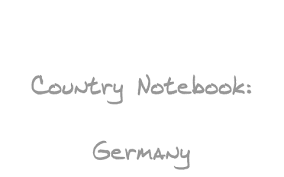
Country Notebook, Part 1
Paper Overview
The first stage in the planning process is a preliminary country analysis.
The marketer needs basic information to evaluate a country marketís potential, identify problems that would eliminate a country from further consideration, identify aspects of the countryís environment that need further study, evaluate the components of the marketing mix for possible adaptation, and develop a strategic marketing plan.
Many companies, large and small, have a country notebook for each country in which they do business. The country notebook contains information a marketer should be aware of when making decisions involving a specific country market.
As new information is collected, the country notebook is continually updated by the country or product manager.
Whenever a marketing decision is made involving a country, the country notebook is the first database consulted. New-product introductions, changes in advertising programs, and other marketing program decisions begin with the country notebook. It also serves as a quick introduction for new personnel assuming responsibility for a country market.
Together this project encompasses four separate section/guidelines for collection and analysis of market data and preparation of a country notebook:
(1) Cultural analysis
(2) Economic analysis,
(3) Market audit and competitive analysis, and
(4) Preliminary marketing plan.
These guidelines suggest the kinds of information a marketer can gather to enhance planning. The points in each of the guidelines are general.
They are designed to provide direction to areas to explore for relevant data. In each guideline, specific points must be adapted to reflect a companyís products and/or services.
The decision as to the appropriateness of specific data and the depth of coverage depends on company objectives, product characteristics, and the country market. Keep in mind that not all points in the guidelines are important for some countries or some products and should be ignored.
Cultural Analysis (Part 1):
The data suggested in the cultural analysis include information that helps the marketer make market planning decisions. However, its application extends beyond product and market analysis to being an important source of information for someone interested in understanding business customs and other important cultural features of the country. The information in this analysis must be more than a collection of facts.
Whoever is responsible for the preparation of this material should attempt to interpret the meaning of cultural information. That is, how does the information help in understanding the effect on the market? For example, the fact that almost all the populations of Italy and Mexico are Catholic is an interesting statistic but not nearly as useful as understanding the effect of Catholicism on values, beliefs, and other aspects of market behavior.
Furthermore, even though both countries are predominantly Catholic, the influence of their individual and unique interpretation and practice of Catholicism can result in important differences in market behavior.
Guidelines
You are to select a country of interest where you would like to introduce a new product, service, or brand (Mexico and Canada are excluded).
Research that country using the resource links provided under Course Resources (please document these sources). Use the following outline to help analyze that country:
I. Introduction – Include short profiles of the company, the product to be exported, and the country with which you wish to trade.
II. Brief discussion of the countryís relevant history
III. Geographical setting
A. Location
B. Climate
C. Topography
IV. Social institutions
A. Family
1. The nuclear family
2. The extended family
3. Dynamics of the family
a. Parental roles
b. Marriage and courtship
4. Female/male roles (changing or static?)
B. Education
1. The role of education in society
a. Primary education (quality, levels of development, etc.)
b. Secondary education (quality, levels of development, etc.)
c. Higher education (quality, levels of development, etc.)
2. Literacy rates
C. Political system
1. Political structure
2. Political parties
3. Stability of government
4. Special taxes
5. Role of local government
D. Legal system
1. Organization of the judiciary system
2. Code, common, socialist, or Islamic-law country?
3. Participation in patents, trademarks, and other conventions
E. Social organizations
1. Group behavior
2. Social classes
3. Clubs, other organizations
4. Race, ethnicity, and subcultures
F. Business customs and practices
V. Religion and aesthetics
A. Religion and other belief systems
1. Orthodox doctrines and structures
2. Relationship with the people
3. Which religions are prominent?
4. Membership of each religion
5. Any powerful or influential cults?
B. Aesthetics
1. Visual arts (fine arts, plastics, graphics, public art, colors, etc.)
2. Music
3. Drama, ballet, and other performing arts
4. Folklore and relevant symbols
VI. Living conditions
A. Diet and nutrition
1. Meat and vegetable consumption rates
2. Typical meals
3. Malnutrition rates
4. Foods available
B. Housing
1. Types of housing available
2. Do most people own or rent?
3. Do most people live in one-family dwellings or with other families?
C. Clothing
1. National dress
2. Types of clothing worn at work
D. Recreation, sports, and other leisure activities
1. Types available and in demand
2. Percentage of income spent on such activities
E. Social security
F. Healthcare
VII. Language
A. Official language(s)
B. Spoken versus written language(s)
C. Dialects
VIII. A Briefing on Negotiation Style (ours and theirs)
We can write this or a similar paper for you! Simply fill the order form!




